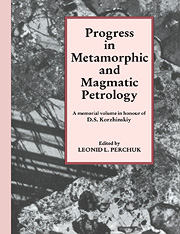Book contents
- Frontmatter
- Contents
- List of contributors
- Preface
- To the memory of Dmitriy Sergeyevich Korzhinskiy
- List of symbols
- PART I General thermodynamics and mineral equilibria including geothermobarometry
- PART II Metamorphic and metasomatic processes
- PART III The mantle and magmatic processes
- 13 Complications in the melting of silicate minerals from atmospheric to high pressures
- 14 Evolution of the lithosphere, and inferred increasing size of mantle convection cells over geologic time
- 15 Temperatures in and around cooling magma bodies
- 16 Experimental studies of the system Mg2SiO4–SiO2–H2 at pressures 10−2–10−10 bar and at temperatures to 1650 °C: application to condensation and vaporization processes in the primitive solar nebula
- 17 Volatiles in magmatic liquids
16 - Experimental studies of the system Mg2SiO4–SiO2–H2 at pressures 10−2–10−10 bar and at temperatures to 1650 °C: application to condensation and vaporization processes in the primitive solar nebula
Published online by Cambridge University Press: 24 November 2009
- Frontmatter
- Contents
- List of contributors
- Preface
- To the memory of Dmitriy Sergeyevich Korzhinskiy
- List of symbols
- PART I General thermodynamics and mineral equilibria including geothermobarometry
- PART II Metamorphic and metasomatic processes
- PART III The mantle and magmatic processes
- 13 Complications in the melting of silicate minerals from atmospheric to high pressures
- 14 Evolution of the lithosphere, and inferred increasing size of mantle convection cells over geologic time
- 15 Temperatures in and around cooling magma bodies
- 16 Experimental studies of the system Mg2SiO4–SiO2–H2 at pressures 10−2–10−10 bar and at temperatures to 1650 °C: application to condensation and vaporization processes in the primitive solar nebula
- 17 Volatiles in magmatic liquids
Summary
Introduction
Forsterite and enstatite (or forsteritic olivine and enstatitic pyroxene) are two major constituent minerals in chondrites. These minerals could have been formed in the primitive solar nebula by condensation of gas or crystallization of liquid or recrystallization associated with vaporization. The phase relations involving forsterite, enstatite, H2-rich gas and liquid, particularly those near the ‘triple point’, therefore, are necessary for understanding the conditions of formation of these minerals.
The pressure–temperature conditions required for condensation of forsterite and enstatite from the primitive solar nebula gas have been investigated by means of thermodynamic calculations (e.g., Wood, 1963, Lord, 1965, Larimer, 1967, Blander & Katz, 1967, Grossman, 1972, Grossman & Larimer, 1974, Saxena & Eriksson, 1983) and by the suggested phase relations in the system forsterite–H2 under solar nebula conditions (Yoder, 1976). The results of thermodynamic calculations (Grossman, 1972) indicate that with cooling of gas of solar composition at total pressure of 10−3 atm, forsterite condenses at 1444 K and begins to react with gas to form enstatite at 1349 K. The ratio of forsterite to enstatite decreases with further cooling. A reaction relation between Si-rich gas and forsterite to produce enstatite was also suggested for experimental observations (Sata et al., 1978). The reaction relation of forsterite and gas to produce enstatite is important for understanding Mg/Si fractionation in the nebula.
Information
- Type
- Chapter
- Information
- Progress in Metamorphic and Magmatic PetrologyA Memorial Volume in Honour of D. S. Korzhinskiy, pp. 411 - 434Publisher: Cambridge University PressPrint publication year: 1991
Accessibility standard: Unknown
- 2
- Cited by
